South Georgia sits amidst the furious if not screaming fifties latitude belt, the circum Antarctic westerlies. This region is famous for the endless march of storms parading around Antarctica. The island is south of the Antarctic Convergence, preventing any truly warm season from persisting. The cool maritime climate leads to numerous glaciers covering a majority of the island and quite low equilibrium line altitudes. Sugden, Clapperton and Pelto (1989-sorry no good link to this paper, one of the first I worked on), 1989 noted the ELA of Neumayer Glacier at 550 m. The tidewater glaciers of South Georgia in general maintained fairly advanced positions unitl 1980. Gordon et al., (2008) observed that larger tidewater and sea-calving valley and outlet glaciers generally remained in relatively advanced positions until the 1980s. After 1980 most glaciers receded; some of these retreats have been dramatic and a number of small mountain glaciers will soon disappear. Neumayer Glacier is one of the large tidewater glaciers on South Georgia. Maps from the British Antarctic Survey (BAS) and satellite imagery are used here to assess the changes in this glacier terminus position. A view of the entire glacier in 2006 from Google Earth, from beyond its calving terminus, indicates indicates the glacier remains vigorous with extensive crevassing at the calving front and extensive snowcover above the ELA.  The BAS has a mapping function that provides glacier front positions since early in the 20th century. For Neumayer Glacier the 1938 position is 3.5 km down fjord from the 2006 position. There was essentially no retreat up to 1974 and limited retreat up to 1993.
The BAS has a mapping function that provides glacier front positions since early in the 20th century. For Neumayer Glacier the 1938 position is 3.5 km down fjord from the 2006 position. There was essentially no retreat up to 1974 and limited retreat up to 1993.  . In 2004 and 2009 NASA provided two images of Neumayer Glacier indicating retreat from 2004 when the glacier extended to the down fjord edge of a tributary glacier from the south. By 2009 the glacier has retreated upglacier of this now former tributary, this retreat is 1300 m. Landsat Image from 1999 to 2014 indicates retreat of 4800 m from the red to the green arrow , this is 320 m/year. The glacier appears to have retreated into a deeper section of the fjord then where it ended from 1970-2002. This will enhance calving from the glacier, and promote additional mass loss and retreat. This retreat will impact Konig Glacier which is connected to the Neumayer Glacier. Calving rate increases with water depth and the degree of glacier. Pelto and Warren (1991) provided an expanded version of the relationship first quantified by Brown and others (1982). In the you would have never guessed it category, is the glacier retreat has been an aid to the rat population, as the glacier tongues used to corner populations.
. In 2004 and 2009 NASA provided two images of Neumayer Glacier indicating retreat from 2004 when the glacier extended to the down fjord edge of a tributary glacier from the south. By 2009 the glacier has retreated upglacier of this now former tributary, this retreat is 1300 m. Landsat Image from 1999 to 2014 indicates retreat of 4800 m from the red to the green arrow , this is 320 m/year. The glacier appears to have retreated into a deeper section of the fjord then where it ended from 1970-2002. This will enhance calving from the glacier, and promote additional mass loss and retreat. This retreat will impact Konig Glacier which is connected to the Neumayer Glacier. Calving rate increases with water depth and the degree of glacier. Pelto and Warren (1991) provided an expanded version of the relationship first quantified by Brown and others (1982). In the you would have never guessed it category, is the glacier retreat has been an aid to the rat population, as the glacier tongues used to corner populations.


Tag: glacier melting
Rembesdalsskaka, Norway Current Retreat
The Hardangerjøkulen Ice Cap is situated in southern Norway,150 km from the western coast. This elliptical shaped ice cap covers 73 square kilometers and ranges in altitude from 1020 to 1865 meters. It rises above the community of Finse offering access to snow year around. Norway has the most comprehensive glacier monitoring program in the world, mainly due to the heavy reliance on hydropower, for which glacier runoff is a key input. The Rembesdalsskaka drains west from the ice cap, the left side feeding the Rembesdalsvatnet Reservoir.  The research is led by the The Norwegian Water Resources and Energy Directorate (NVE). Statkraft runs the Sima power station that is fed from Rembesdalsvatnet Reservoir and the larger Sysenvatn fed by the southern glaciers of Hardanger. This system produces 620 Mw of hydropower. The largest glacier draining the western side of the ice cap is the Rembesdalsskaka with an area of 17 square kilometers. Since the LIA maximum Rembesdalsskaka has retreated almost two kilometres, The ice cap decreased in volume from the Little ice Age until 1917, followed by an increase in ice cap volume and glacial advance until 1928, . After this a period with high negative mass balances cause a rapid retreat of Hardangerjøkulen until 1950. Retreat continued until 1961, but the rate declined. From 1961 to 1995 mass balances increased, with the highest balances in the late 1980’s and early 1990’s. This resulted in an advance of Rembesdalsskaka. Since the early 1990’s mass balance has been negative, with exceptionally negative years in. This has led to the retreat of the Rembesdalsskaka each year from 2000-2009 a total of 307 meters.
The research is led by the The Norwegian Water Resources and Energy Directorate (NVE). Statkraft runs the Sima power station that is fed from Rembesdalsvatnet Reservoir and the larger Sysenvatn fed by the southern glaciers of Hardanger. This system produces 620 Mw of hydropower. The largest glacier draining the western side of the ice cap is the Rembesdalsskaka with an area of 17 square kilometers. Since the LIA maximum Rembesdalsskaka has retreated almost two kilometres, The ice cap decreased in volume from the Little ice Age until 1917, followed by an increase in ice cap volume and glacial advance until 1928, . After this a period with high negative mass balances cause a rapid retreat of Hardangerjøkulen until 1950. Retreat continued until 1961, but the rate declined. From 1961 to 1995 mass balances increased, with the highest balances in the late 1980’s and early 1990’s. This resulted in an advance of Rembesdalsskaka. Since the early 1990’s mass balance has been negative, with exceptionally negative years in. This has led to the retreat of the Rembesdalsskaka each year from 2000-2009 a total of 307 meters.  The retreat is measured each year from a benchmark painted on rock beyond the terminus, reported to the NVE and then to the World Glacier Monitoring Service. In 2009 the NVE reported 19 glaciers retreated, 3 were stationary and one advanced.
The retreat is measured each year from a benchmark painted on rock beyond the terminus, reported to the NVE and then to the World Glacier Monitoring Service. In 2009 the NVE reported 19 glaciers retreated, 3 were stationary and one advanced.
Tasman Glacier Retreat
Update for 2/22/2011-the Tasman Glacier’s thin and weak terminus area, see in the GE image below, in Tasman Lake shed some large icebergs due to the earthquake generating some substantial waves in the lake. The post earthquake image with numerous fresh icebergs is the second below and is from the EPA. 
 No word on the Hooker Glacier in the next valley west, which also calves into an expanding lake or Murchison Glacier in the next valley east. There is a Tasman Glacier update in 2013.
No word on the Hooker Glacier in the next valley west, which also calves into an expanding lake or Murchison Glacier in the next valley east. There is a Tasman Glacier update in 2013. . The New Zealand National Institute of Water and Atmospheric Research has been examining the changes in volume and snowline on New Zealand Glaciers since 1977. This survey has concluded for 2009 they same observation as for 2007 and 2008, the glaciers are shrinking. An examination of the recent volume changes on the glacier indicate that the volume has been particularly negative since 1998.
. The New Zealand National Institute of Water and Atmospheric Research has been examining the changes in volume and snowline on New Zealand Glaciers since 1977. This survey has concluded for 2009 they same observation as for 2007 and 2008, the glaciers are shrinking. An examination of the recent volume changes on the glacier indicate that the volume has been particularly negative since 1998. . This followed a period of relatively positive mass balance from 1990-1997, which made the New Zealand glaciers the least rapidly retreating glaciers in the world. For Tasman Glacier the retreat has been ongoing, the NWIA has noted a retreat of 180 m per year on average since the 1990’s. The proglacial lake at the terminus continues to expand as the glacier retreats upvalley. The lake is deep with most of the lake exceeding 100 metes in depth, and the valley has little gradient, thus the retreat will continue. It has been noted by researchers at Massey University that it is just to warm for the terminus area at 730 m to endure. Imagery of Tasman Glacier indicates the future it faces. There was no lake in 1973 and now it is more than 7 km long. The glacier appears quite rotten along the ice margin and poised for further retreat. The glacier drains a valley just east of the highest mountains in the range Mount Cook and Mount Tasman.
. This followed a period of relatively positive mass balance from 1990-1997, which made the New Zealand glaciers the least rapidly retreating glaciers in the world. For Tasman Glacier the retreat has been ongoing, the NWIA has noted a retreat of 180 m per year on average since the 1990’s. The proglacial lake at the terminus continues to expand as the glacier retreats upvalley. The lake is deep with most of the lake exceeding 100 metes in depth, and the valley has little gradient, thus the retreat will continue. It has been noted by researchers at Massey University that it is just to warm for the terminus area at 730 m to endure. Imagery of Tasman Glacier indicates the future it faces. There was no lake in 1973 and now it is more than 7 km long. The glacier appears quite rotten along the ice margin and poised for further retreat. The glacier drains a valley just east of the highest mountains in the range Mount Cook and Mount Tasman.  . The image above has a blue line up the center of the glacier from the former terminus at the end of the lake too the head of the glacier. The upper image is from 2007 and the lower image from 2009. In the latter image the lake has expanded considerably. The disconnected lakes and debris covered ice on the left side-west side of the glacier has been replaced by all lake. Icebergs are afloat in this lake, they do not survive very long. The debris cover itself insulates the glacier ice from melting, slowing the process. However, the process due to the warmth and increased melting of the last decade has been increasing.
. The image above has a blue line up the center of the glacier from the former terminus at the end of the lake too the head of the glacier. The upper image is from 2007 and the lower image from 2009. In the latter image the lake has expanded considerably. The disconnected lakes and debris covered ice on the left side-west side of the glacier has been replaced by all lake. Icebergs are afloat in this lake, they do not survive very long. The debris cover itself insulates the glacier ice from melting, slowing the process. However, the process due to the warmth and increased melting of the last decade has been increasing.


In the image below is a closeup of the section of ice that has now disintegrated, before it did. You can see the crevasses in some of the icebergs too. This is a rapidly changing environment due to the ongoing climate warming.
Grasshopper Glacier, Montana-nearly gone
Grasshopper Glacier, the largest is located about 19 km. north of Cook, Montana within Custer National Forest. The glacier on Iceberg Peak occupies a north facing cirque at nearly 3300 m. (11,000 ft.). In 1940, it was about 1.6 km. wide and on its northwest side terminated in a 15-m. cliff. In 1966, seen below, the glacier had an area of 0.42 square kilometers.  The name of the glacier is derived from the myriads of grasshoppers that were embedded in the ice. These grasshoppers either were downed by sudden storms or were carried over the glacier by strong air currents, where the cold forced them onto the ice surface. The grasshoppers are an extinct type of Rocky Mountain grasshoppper Melanoplus spretus. They perished here, were buried by new snow and preserved. At the time the glacier ended in a small lake. Progressively the glacier has retreated. By 1966 it was 0.6 km long, in 1994, seen below, 0.36 km long and in 2006 0.27 km long.
The name of the glacier is derived from the myriads of grasshoppers that were embedded in the ice. These grasshoppers either were downed by sudden storms or were carried over the glacier by strong air currents, where the cold forced them onto the ice surface. The grasshoppers are an extinct type of Rocky Mountain grasshoppper Melanoplus spretus. They perished here, were buried by new snow and preserved. At the time the glacier ended in a small lake. Progressively the glacier has retreated. By 1966 it was 0.6 km long, in 1994, seen below, 0.36 km long and in 2006 0.27 km long. 
In 2005 this glacier has ceased to exist as a glacier, there are a few remnant perennial snow and ice patches the largest with an area of 0.05 km2. In the majority of recent summers the glacier has lost all of its snowcover. Glacier survival is dependent on consistent accumulation retained on the glacier each summer, this glacier will not survive. The glacier has continued its rapid recession and the further segmentation into small disconnected segments, heralds the end of an active glacier. We do have a gorgeous new alpine lake in its place. Notice the basin is still largely devoid of plant life and the surface still has the color of newly exposed-deposited sediments. 

Denali National Park, East Taklanika Glacier retreat
The glaciers of Denali National Park are shrinking. The National Park Service has been chronicling the retreat with repeat photographs of glaciers from locations where historic photographs exist. The program has been a cooperation between glaciologist Guy Adema and photographer Ron Karpillo. One example is East Taklanika Glacier. This glacier drains north from the east ridge of Mount Scott. The glacier is currently 5.1 km long, the lower 2.2 km of the glacier is nearly completely debris covered. That ice is beneath the debris is clear from the lack of a the glacier melt fed river in the valley bottom and the color of the sediments which is darker, largely because the debris is wet from the ice melt underneath. The glacier in the center of the Google Earth satellite view below is East Taklanika Glacier. 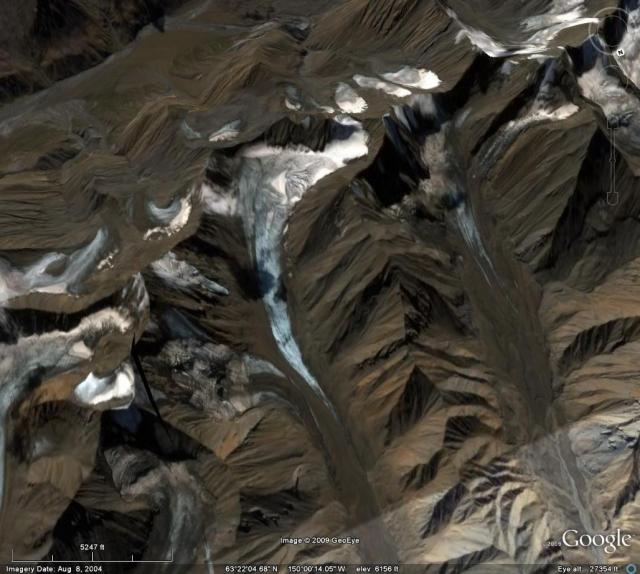 The glacier has retreated 1100 m between 1916 and 2004 in the phtographs of Ron Karpillo and Stephen Capps. There is a lateral moraine in the foreground of the 2004 Ron Karpillo image. This marks the former surface elevation of the glacier during the Little Ice Age. Since that time the lower section of the glacier has lost over 100 m of ice thickness.
The glacier has retreated 1100 m between 1916 and 2004 in the phtographs of Ron Karpillo and Stephen Capps. There is a lateral moraine in the foreground of the 2004 Ron Karpillo image. This marks the former surface elevation of the glacier during the Little Ice Age. Since that time the lower section of the glacier has lost over 100 m of ice thickness. 
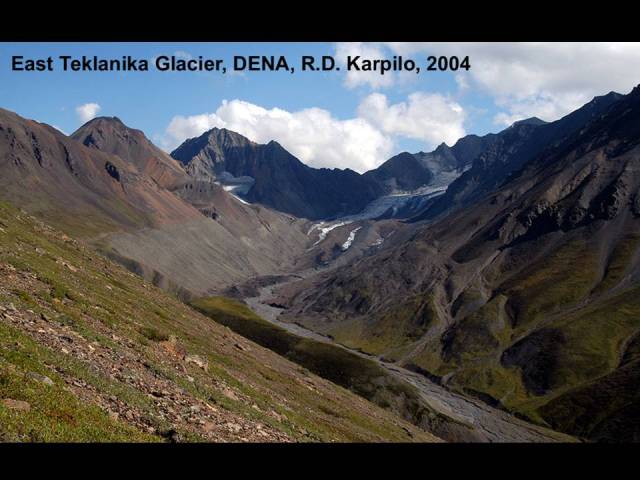 The retreat is ongoing. Medial moraines are bands of debris on the surface of a glacier that separate tributaries of a glacier. The moraines represent material eroded from the edge of the tributaries before they join. This material does not appear at the surface until you reach the ablation zone where melting dominates. In the accumulation zone such debris bands would be buried. On East Taklanika Glacier the debris bands extend to within 1 kilometer of the head of the glacier. For a glacier to be in equilibrium a glacier needs to have at least 50 % of its area in the accumulation zone at the end of the summer. Based on the satellite image hear showing 10% of its area in the accumulation zone and the extent of the medial moraine indicating no more than 25% of the glacier area above the moraine. This glacier needs to lose the lower 2-3 kilometers to be in equilibrium. This may not be enough. A glance at the glaciers around East Taklanika, indicate the same story, very little retained snowpack. Some of these glaciers have an accumulation area ratio (% of glacier snow covered at the end of the summer), of zero. This is like having no income, and plenty of expenditures and the result for your bank account, net loss and without some change eventual bankruptcy. The story of retreat is the same though the snowpack extent greater on the Juneau Icefield. The retreat of East Taklanika is slowed considerably by the debris cover which protects the ice underneath from melting as fast. This glacier is a long way from completing its retreat to adjust to current climate.
The retreat is ongoing. Medial moraines are bands of debris on the surface of a glacier that separate tributaries of a glacier. The moraines represent material eroded from the edge of the tributaries before they join. This material does not appear at the surface until you reach the ablation zone where melting dominates. In the accumulation zone such debris bands would be buried. On East Taklanika Glacier the debris bands extend to within 1 kilometer of the head of the glacier. For a glacier to be in equilibrium a glacier needs to have at least 50 % of its area in the accumulation zone at the end of the summer. Based on the satellite image hear showing 10% of its area in the accumulation zone and the extent of the medial moraine indicating no more than 25% of the glacier area above the moraine. This glacier needs to lose the lower 2-3 kilometers to be in equilibrium. This may not be enough. A glance at the glaciers around East Taklanika, indicate the same story, very little retained snowpack. Some of these glaciers have an accumulation area ratio (% of glacier snow covered at the end of the summer), of zero. This is like having no income, and plenty of expenditures and the result for your bank account, net loss and without some change eventual bankruptcy. The story of retreat is the same though the snowpack extent greater on the Juneau Icefield. The retreat of East Taklanika is slowed considerably by the debris cover which protects the ice underneath from melting as fast. This glacier is a long way from completing its retreat to adjust to current climate. 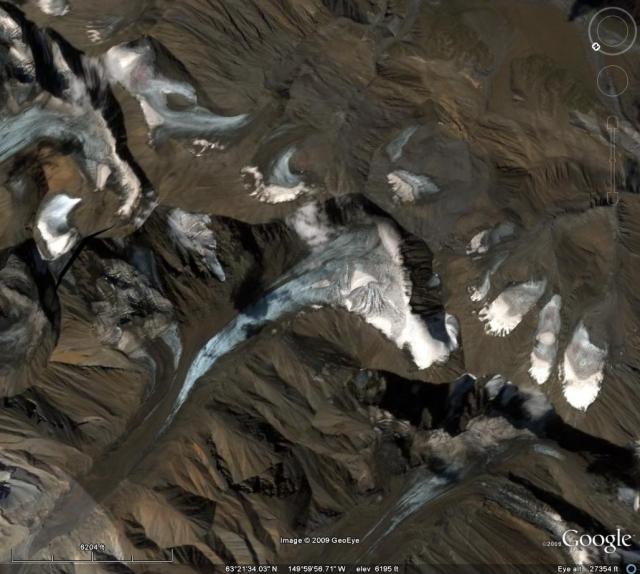
Gilkey Glacier Retreat, Juneau Icefield
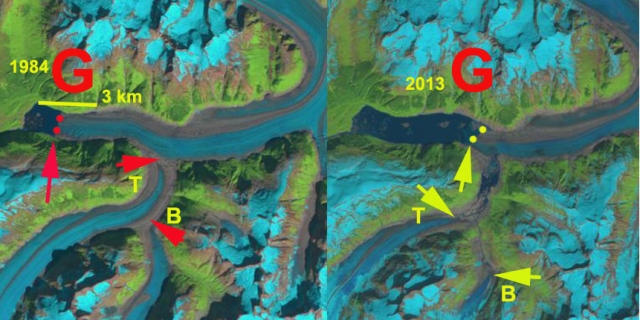 Above is a paired Landsat image from 1984 left and 2013 right indicaing the 3200 m retreat during this period of Gilkey Glacier.The Juneau Icefield Research Program has long monitored the mass balance of the Lemon Creek and Taku Glacier on the Juneau Icefield. This program begun by Maynard Miller in 1946 and continuing through today has also monitored the terminus behavior of the icefields outlet glaciers. Of the 17 significant outlet glaciers 5 have retreated more than 500 m since 1948, 11 more than 1000 m, and one glacier the Taku has advanced. I have a chance to visit the glaciers during a number of summers over the last 25 years as part of this ongoing annual program. The Gilkey Glacier is a 32 km long 245 km2 outlet glacier flowing west from the Juneau Icefield. In 1948 it terminate at the head of a braided outwash plain. At that time it was joined 5 km above the terminus by the Battle and Thiel Glaciers from the south.
Above is a paired Landsat image from 1984 left and 2013 right indicaing the 3200 m retreat during this period of Gilkey Glacier.The Juneau Icefield Research Program has long monitored the mass balance of the Lemon Creek and Taku Glacier on the Juneau Icefield. This program begun by Maynard Miller in 1946 and continuing through today has also monitored the terminus behavior of the icefields outlet glaciers. Of the 17 significant outlet glaciers 5 have retreated more than 500 m since 1948, 11 more than 1000 m, and one glacier the Taku has advanced. I have a chance to visit the glaciers during a number of summers over the last 25 years as part of this ongoing annual program. The Gilkey Glacier is a 32 km long 245 km2 outlet glacier flowing west from the Juneau Icefield. In 1948 it terminate at the head of a braided outwash plain. At that time it was joined 5 km above the terminus by the Battle and Thiel Glaciers from the south.  All three of these glaciers drain from the Juneau Iceifeld accumulation zone between 1500 and 2000 m, which maintain consistent snow cover. From 1948 to 1967 the Gilkey Glacier retreated 600 m and in 1961 a proglacial lake began to form. By 2005 Gilkey Glacier had retreated another 3200 m , generating a proglacial lake that is now 3.9 kilometers long, which is approximately the amount of retreat in the last 60 years as well.
All three of these glaciers drain from the Juneau Iceifeld accumulation zone between 1500 and 2000 m, which maintain consistent snow cover. From 1948 to 1967 the Gilkey Glacier retreated 600 m and in 1961 a proglacial lake began to form. By 2005 Gilkey Glacier had retreated another 3200 m , generating a proglacial lake that is now 3.9 kilometers long, which is approximately the amount of retreat in the last 60 years as well. 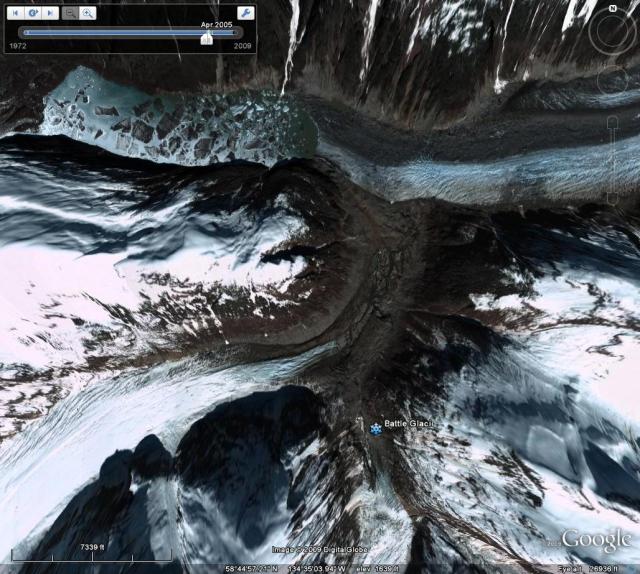 The lake is partly filled with large icebergs from disintegration of the, note below in an image from Scott McGee of JIRP,Gilkey terminus. The lake is currently terminating in this still growing lake. Approximately half of this retreat occurred after a 1991 satellite image indicated the lake was close to half its current size. The retreat has been resulted from calving icebergs into the new lake as well as thinning from melting in the lower reach of the glacier. The extensive debris cover and lack of crevassing in the lower 1500 meters of the glacier indicates that this section is stagnant and will break up soon.
The lake is partly filled with large icebergs from disintegration of the, note below in an image from Scott McGee of JIRP,Gilkey terminus. The lake is currently terminating in this still growing lake. Approximately half of this retreat occurred after a 1991 satellite image indicated the lake was close to half its current size. The retreat has been resulted from calving icebergs into the new lake as well as thinning from melting in the lower reach of the glacier. The extensive debris cover and lack of crevassing in the lower 1500 meters of the glacier indicates that this section is stagnant and will break up soon. 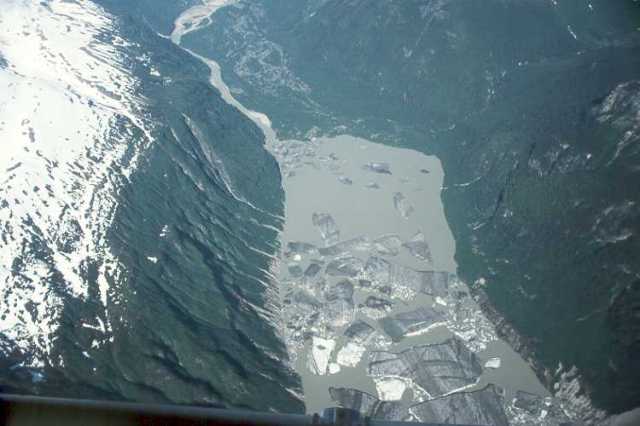
Gilkey Glacier was in 1955 joined by the tributary glaciers Battle and Thiel Glacier. A visit to the Battle Glacier in 1982 indicated that it had separated from the Gilkey Glacier and the Thiel Glacier, but the Thiel Glacier was still connected. By 1991 the Thiel Glacier had separated. Today these glaciers terminate 3200 m and 1700 m up their respective valleys from Gilkey Glacier. Thiel has retreated 1700 m from the Gilkey Glacier. A retreat of 3200 m has created a glacier 70 % its former length. The vast bare valley beyond the terminus is in stark contrast to the map above. Thiel Glacier has extensive lateral moraines extending above the glacier terminus indicating the ongoing retreat. The lower 3 kilometers of this glacier are flat and are downwasting, indicating a substantial retreat is still underway. A view up the valley from the Gilkey toward the terminus of Battle Glacier indicates that most of the area deglaciated was a flat low elevation valley. Now that the glacier is retreating up a steeper slope, the retreat rate of Battle Glacier should slow.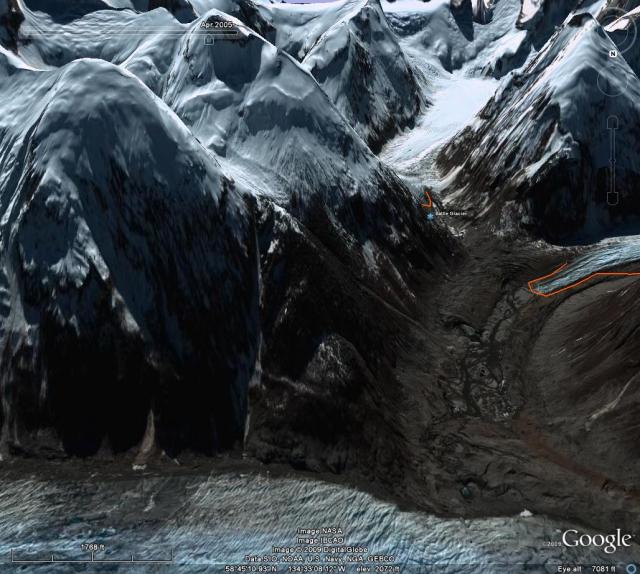
Mass Balance of the Easton Glacier 2009
Immediately below is Easton Glacier on Mt. Baker in the North Cascades in late May 2009. The glacier is still completely snow covered. The bench where the small gray cloud shadows are at 6000 feet averages 20 feet of snow remaining.
 Easton Glacier extends from the terminus at 5600 feet to the slopes near Sherman Crater at 9000 feet. Each summer since 1990 NCGCP has measured the mass balance of this glacier. View Youtube for a pictorial review of the full 2009 field season . The glacier has retreated 300 m since 1990. During this same period the glacier has lost a cumulative mean of 13 m of thickness. Given a thickness in 1990 between 60 and 75 m, this is about 20 % of the total glacier volume. The image below shows the terminus in 2009(green=2009, 2006=brown, red=2003, purple=1993 and yellow=1984).
Easton Glacier extends from the terminus at 5600 feet to the slopes near Sherman Crater at 9000 feet. Each summer since 1990 NCGCP has measured the mass balance of this glacier. View Youtube for a pictorial review of the full 2009 field season . The glacier has retreated 300 m since 1990. During this same period the glacier has lost a cumulative mean of 13 m of thickness. Given a thickness in 1990 between 60 and 75 m, this is about 20 % of the total glacier volume. The image below shows the terminus in 2009(green=2009, 2006=brown, red=2003, purple=1993 and yellow=1984).  Measuring mass balance requires assessing snowpack depth and areal extent at the end of the summer melt season and the amount of melting in areas where blue ice or firn (snow more than a year old) is exposed. Below is measuring crevasse stratigraphy and below that emplacing a stake to measure ablation with weather instruments on it.
Measuring mass balance requires assessing snowpack depth and areal extent at the end of the summer melt season and the amount of melting in areas where blue ice or firn (snow more than a year old) is exposed. Below is measuring crevasse stratigraphy and below that emplacing a stake to measure ablation with weather instruments on it. 

Mass Balance = residual snow accumulation – ice-firn melting.
The melt season began a bit late just when the May picture was taken Winter snowpack was between 75and 90% of normal in the area as of April 1. The melt season had been late to begin and snowpack by late May was near normal. Record heat was experienced at the end of May and the start of June, quickly causing snowpack to fall below normal.Each year we measure the snow depth via probing and crevasse stratigraphy at more than 200 locations. These depth measurements allow the completion of a map of snow distribution. This map is completed in early August and updated, based on a smaller number of observation in late September. The amount of melting is assessed from stakes emplaced in the glacier and the recession of the snowline in areas where snow pack depth has been assessed. below are images from early and then mid-August indicating the rise of the snowline. 

A warm June and July caused exceptional snow pack melt and by early August when we began assessing snow pack depth retained, the snowcover had receded to the 6400 foot level, 300-400 feet higher than normal. Snowpack remained below normal all the way to the 8600 foot level. the snowpack since early July had been rising nearly 100 feet per week. By mid-August at right the snow line on the glacier averaged 6800 feet. By mid and Late September the snowline had risen to 7400 feet a rate of rise of 150 feet per week since mid-August. Below is an image from mid-September 2009.  The amount of melting on the glacier in July was the highest we have measured totaling, 2.1 m. This led to the exposure of a couple of new bedrock knobs evident in the picture at right near the 2100 meters, black arrows. Overall the mass balance of the glacier in 2009 was a negative 2.06 m. This glacier averages 55-70 m in thickness and this mass balance loss represents a 3% volume loss in a single year for the glacier.
The amount of melting on the glacier in July was the highest we have measured totaling, 2.1 m. This led to the exposure of a couple of new bedrock knobs evident in the picture at right near the 2100 meters, black arrows. Overall the mass balance of the glacier in 2009 was a negative 2.06 m. This glacier averages 55-70 m in thickness and this mass balance loss represents a 3% volume loss in a single year for the glacier.

